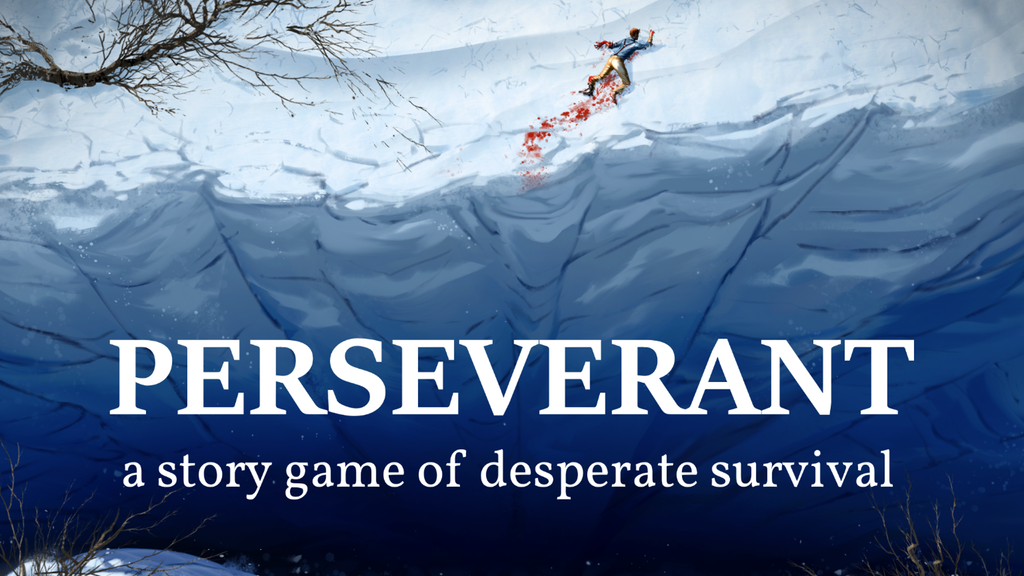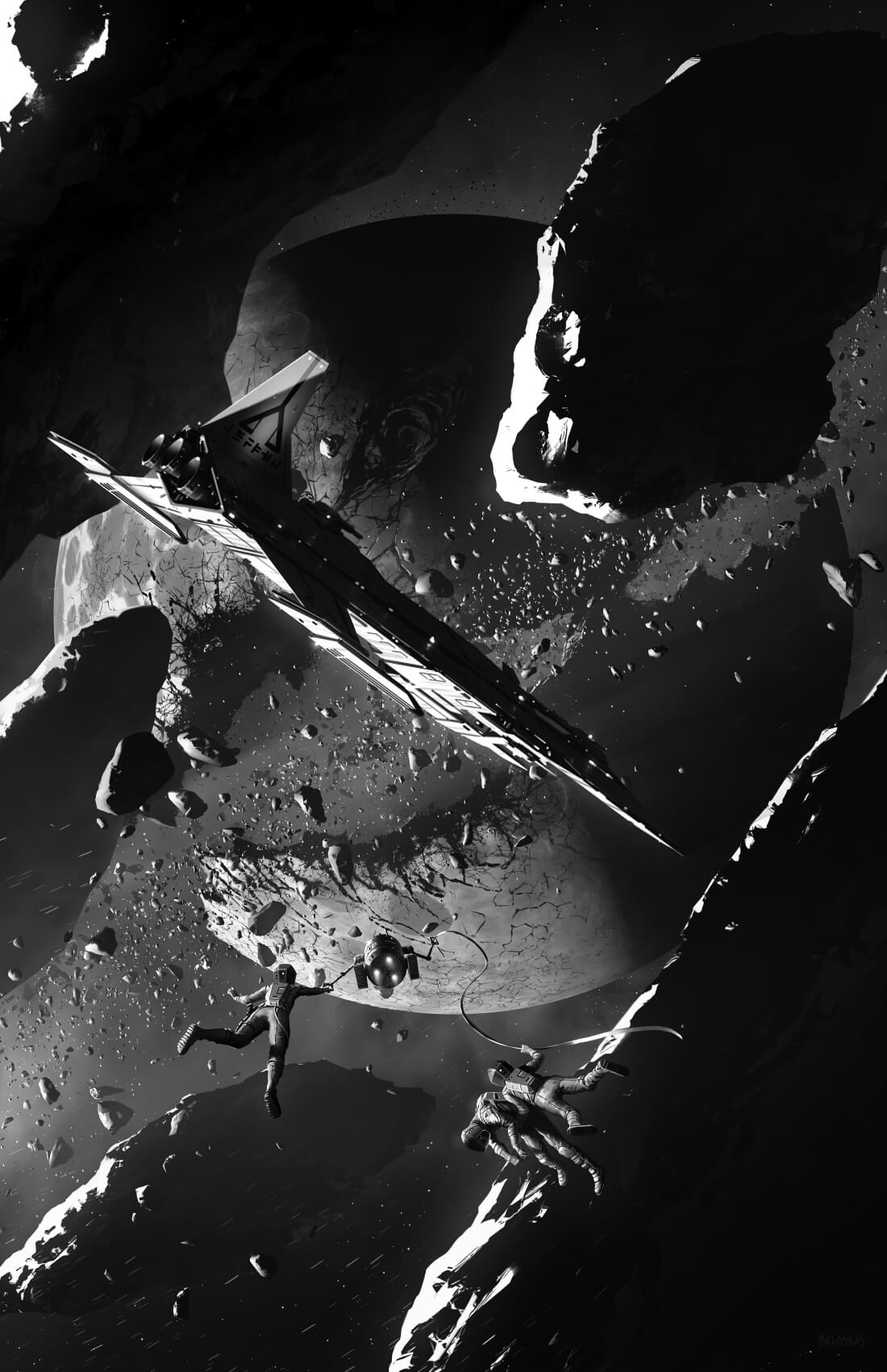
A story game about desperate survival in a harsh land. Create your wilderness, share your plight, and persevere.
What kind of Wilderness will you create? How will you survive? Perseverant helps you tell a complete and compelling story of survival, self-sacrifice, drama, and betrayal in a single session.
We lost our way around the Pamir Mountains; hope dwindled even faster than our food supply. The donkeys were easy to eat; the dogs, not so much. Now, there’s only one source of meat left…
Dying in space is a silent, lingering affair. There’s no sound when you scream, no bacteria to consume your remains. The dead bobbed around our ship’s debris like the rest of us, faces locked in final visages of terror.
Another night, another descent into the tunnels. The sun’s molten flow trailed behind us, illuminating the caves with boiling heat, chasing us closer to the core of the earth. Eyes blind, skin blistered, I follow the shuffling steps of those ahead of me.


Perseverant is a tabletop roleplaying game about the struggle to survive in a brutal wilderness.
To start, players collaborate to create the Wilderness, its significant locales and deadly challenges, how their characters are connected, and why they traverse this hellish landscape.
Throughout play, the characters will confront both the Wilderness and each other, haunted by the grim specter of betrayal and sacrifice. It’s unlikely that everyone will survive.
The game works with any kind of setting–from the arid Silk Road to the vastness of space–so long as there are people determined to pass through an inhospitable environment.
Perseverant is designed to create an entire story in a single session lasting two to four hours, and supports between two and five players. Since it’s a collaborative story game, it doesn’t require a GM or any preparation; you’ll start creating your desperate journey as soon as you sit down to play.

“Collaborating on the locations and challenges at the start of the game gets everyone’s imaginations rolling. It’s amazing and rewarding to see how the game subverts your expectations and makes your locations play out differently than you could ever have anticipated.”
Jason D’Angelo, playtester
“My group tried out a YA-style survival setting, and we were thrilled to see how closely it mapped to our favorite stories: Hatchet, Island of the Blue Dolphins, My Side of the Mountain.
There’s a mechanic in here that’s totally brilliant. When you key your traits, you can’t immediately use those traits again. As the game goes on, you’re forced to access more obscure or buried traits to get the job done. It matches the survival story arc perfectly.
Hannah Shaffer, designer of 14 Days
“Clinging to life in a desolate and dangerous wilderness has never been more enjoyable.”
Karl Larsson, designer of Scavengers RPG


Perseverant is inspired by collaborative story games like Microscope, Downfall, and Fiasco. The game provides players with cues and inspiration (more aggressively than most) to help them create and frame each scene. This firm but flexible mechanism helps prevent them from getting creatively stuck and alleviates the improvisational pressure common in story games.
The game unfolds as the group creates the Wilderness, makes their characters, and determines how (and if) they overcome the journey. The initial collaborative phase–making the Wilderness and coming up with the complex web of characters–gets everyone’s creative juices flowing and aligns the group’s expectations.
In order to unify each story’s theme, the players decide on some of its narrative elements (and aspects of its Wilderness) before getting started. The players won’t know which of these elements will come up during the game, or when, but they create the foundation for a coherent narrative that’s different every time. The unpredictability of these elements’ arrival keeps the tension high and the story interesting.

To start, the group determines the nature, era, tone, and goal of their Wilderness. These elements firmly establish the type of story they want to tell, and give everyone a unified creative palette. For example, a group might decide that they want The Silk Road as their nature, 1257 AD as their era, Realistic and gritty as their tone, and Successfully reach China as their goal.
Next, the group writes up a stack of possible Locations and a stack of Challenge Sources on some index cards. These are the obstacles and places that they’re interested in exploring and that may come up during play.
These Locations and Challenge Sources will influence how the characters face the Wilderness. Maybe they’ll find a frozen waterfall or a pack of hungry wolves; maybe the pack of hungry wolves attacks at the frozen waterfall. Or maybe not–they won’t know until they’re on the journey.

When creating characters, the players determine the characters’ relationships to each other before anything else–even before knowing who’s playing which character. A group might start out saying that one character secretly loves another, but beyond their relationship nobody yet knows anything about these secret lovers.
This allows for unique connections that aren’t tied to a cliche you’d expect to see in fiction. Instead of having the gruff commander and the green recruit’s “tough talk but mutual respect” relationship that’s so common in the genre, the commander might secretly love her subordinate despite it threatening their mission.
Once relationships are established, each player picks a character and determines their traits. A character’s History, Method, Cause, and Fear are all central to how they overcome challenges.
Character traits and relationships are tracked on index cards, and each player has a hand of such cards which defines their character.

Perseverant gameplay consists of scenes, alternating between Challenge scenes and Social scenes. After an initial bout of freeform roleplay, each player takes a turn framing a Challenge scene.
To frame a Challenge scene:
- pull a Location card,
- pull a Challenge Source card,
- and roll on the Trouble Table.
Jessica pulls “Ancient, snow-laden ruins” as her Location card, pulls “Avalanche” as her Challenge Source card, and rolls “A previous choice haunts you” on the Trouble Table. She’ll use these elements to frame the scene.
Joining these three elements inspires and guides the scene, letting it unfold in a way that even its framer could not have predicted. Since the players agreed on the story’s potential elements before starting play, the scene never strays outside the agreed-upon creative sandbox.
But because nobody knows which elements will come into the scene, everybody will be surprised at how the journey unfolds. Scenes stay appropriate, but unpredictable.
While characters have to overcome obstacles and survive the dangers of the Wilderness during Challenge scenes, Social scenes give the characters and opportunity to support or confront one another, to tend to wounds, and to resolve grudges–or admit their long-held feelings.
In Social scenes, players don’t pull Challenge Sources or roll on the Trouble Table, but these scenes are just as mechanically important as Challenge scenes, as they return exhausted Trait and Relationship cards spent during Challenge scenes.
This cycle of scenes mirrors the survival fiction that Perseverant emulates, breaking up the dangerous and desperate with the personal and intimate.

Some Challenge scenes are more difficult and dangerous than others, forcing the players to burn more of their Trait and Relationship cards. As characters get desperate, they’ll be incentivized to sacrifice themselves, betray one another, or rely more on their relationships than their individual competence.
If the characters manage to overcome a challenge, the group can move on to a Social scene and recoup some of their spent cards. If not, not only is the scene’s Challenge Source returned to the stack, but each character must bear the burden of a setback.
A setback might be something simple like an injury or broken equipment, or it could be something more difficult to define, such as paranoia or mental exhaustion. When a character suffers a setback, the player picks the most fitting and relevant trait or relationship impacted by the setback, and that card can no longer be called upon during a Challenge scene until they fix the setback.
While a character’s traits stay about the same throughout the game, their relationships are quite dynamic. As characters earn (and lose) each other’s trust, their relationships evolve. New relationship cards are made after significant scenes, but old relationships are never discarded. This represents the complex web of history built up throughout the journey.
As the characters gain relationships over time, they’ll come to rely more and more on their relationships and less on their traits. Survivalist fiction often follows characters through a similar arc: they’re hardened by determination, but often only make it through due to the connections they’ve established along their path.


The Game
The rules are written and have been playtested for over a year, both by internal and external groups, who have spent hundreds of hours honing the game to what it is today. Esteemed designers such as Hannah Shaffer, Karl Larsson, Elizabeth Chaipraditkul, and Jason Pitre have played the game and given excellent feedback. I’m supremely proud and pleased with how Perseverant plays.
Artwork
Christopher Balaskas is the game’s primary artist, combining his excellent attention to detail and eye for unique compositions. His pieces already adorn this page, but there are many more to come.
All of the art will be black and white, high detail, and full page. Each piece will focus on one of the starting scenarios available in the back of the book. My skills as an art director have increased dramatically over the last couple of years, ensuring each piece will fit thematically and stylistically. We’ll include evocative and tonally appropriate illustrations for each of the three starting scenarios, along with any more scenarios we achieve through stretch goals.
The PDF
The game will be released as a DRM-free PDF at DriveThru RPG and bendutter.com. Additional e-reader friendly formats will be included with the final version of the game.
The Book
Physical copies are printed in black and white on heavyweight paper from DriveThru RPG. I’ve worked with them on several other projects, and have been consistently happy with their quality. The book will be 5.5×8.5″, softcover, and have about 70 pages of content.
The Rough Text
If you’re interested in reading the rough rules or giving the game a playthrough, here are links to the Quick Start Rules and the current Beta Draft.